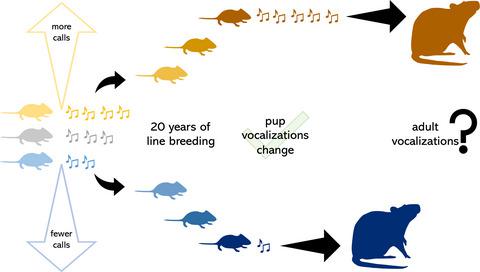Our official English website, www.x-mol.net, welcomes your
feedback! (Note: you will need to create a separate account there.)
Selection on ultrasonic call rate in neonatal rats affects low frequency, but not ultrasonic, vocalizations in adults
Ethology ( IF 1.3 ) Pub Date : 2020-06-23 , DOI: 10.1111/eth.13075 Raffaela Lesch 1 , Andrea Orozco 2 , Margaret Shilling 2 , Betty Zimmerberg 2 , W Tecumseh Fitch 1
Ethology ( IF 1.3 ) Pub Date : 2020-06-23 , DOI: 10.1111/eth.13075 Raffaela Lesch 1 , Andrea Orozco 2 , Margaret Shilling 2 , Betty Zimmerberg 2 , W Tecumseh Fitch 1
Affiliation

|
In this experiment, we studied a rodent model selected over 57 generations for high or low rates of ultrasonic vocalizations (USVs) during maternal separation as pups. We investigated the influence of this breeding on the adult animals’ subsequent vocal output, comparing acoustic variables across developmental stages. We hypothesized that selection on pup USV rate would impact adult USV production without affecting lower frequency calls. Contrary to this hypothesis, we found neither number of USV calls or other acoustic variables to differ among selected adult lines. Instead, we found that pup USV selection mainly affected adults’ low‐frequency (human‐audible) calls. Furthermore, low‐frequency vocalizations did not fully fit a predicted correlation between body weight and fundamental frequency: high line males, although the heaviest on average, did not produce the lowest fundamental frequencies. Our findings suggest that selection for early ultrasonic vocal behaviour pleiotropically results in changes in anatomical production mechanisms and/or neural control affecting low‐frequency calls.
中文翻译:

新生大鼠超声呼叫率的选择影响成年大鼠的低频发声,但不影响超声发声
在本实验中,我们研究了一个啮齿动物模型,该模型选择了超过 57 代,在幼崽与母体分离期间进行高或低的超声波发声 (USV) 率。我们研究了这种繁殖对成年动物随后发声的影响,比较了各个发育阶段的声学变量。我们假设对幼犬 USV 速率的选择会影响成年 USV 的产量,而不影响较低频率的叫声。与这一假设相反,我们发现选定的成年品系之间 USV 呼叫数量或其他声学变量均没有差异。相反,我们发现幼犬 USV 的选择主要影响成年犬的低频(人类可听)叫声。此外,低频发声并不完全符合体重和基频之间的预测相关性:高线雄性虽然平均体重最重,但并没有产生最低的基频。我们的研究结果表明,对早期超声发声行为的选择会多效性地导致影响低频叫声的解剖产生机制和/或神经控制的变化。
更新日期:2020-06-23
中文翻译:

新生大鼠超声呼叫率的选择影响成年大鼠的低频发声,但不影响超声发声
在本实验中,我们研究了一个啮齿动物模型,该模型选择了超过 57 代,在幼崽与母体分离期间进行高或低的超声波发声 (USV) 率。我们研究了这种繁殖对成年动物随后发声的影响,比较了各个发育阶段的声学变量。我们假设对幼犬 USV 速率的选择会影响成年 USV 的产量,而不影响较低频率的叫声。与这一假设相反,我们发现选定的成年品系之间 USV 呼叫数量或其他声学变量均没有差异。相反,我们发现幼犬 USV 的选择主要影响成年犬的低频(人类可听)叫声。此外,低频发声并不完全符合体重和基频之间的预测相关性:高线雄性虽然平均体重最重,但并没有产生最低的基频。我们的研究结果表明,对早期超声发声行为的选择会多效性地导致影响低频叫声的解剖产生机制和/或神经控制的变化。











































 京公网安备 11010802027423号
京公网安备 11010802027423号